The Bikers Guide to St. Andrew's by-the-Sea
Cafe Ride 1
Much of online discourse today is really about how to live. How we ought to live. How one might live. Why Europe is better than the US and why the US is better than Europe. About what one should eat, and when they should eat it. About whether sunlight is bad or good for humans (I don’t think this one in particular has ever been more obvious). About when we should enjoy our coffee and how often we should hydrate. About how many macro-nutrients we should have to be ‘optimal’ - whatever that means.
I don’t think you’ll find it surprising to know that I find most of these online debates to be nonsense. Modern, endless bickering about the details. For example - how many macro-nutrients the average person should have in a day is meaningless compared to the simple advice ‘Eat whole foods, get some sun, and spend time with people you love.’
However - I do think that the question of how to live - of what the average day should and could look like is a real question of consequence. It might be the question.
“The idea that you need to live what you preach should be a common-sense truth for all expertise, especially urban planning, where, at least metaphorically, you should probably live in the town you design.” - Chris Arnade
I’m working on a longer piece on this, inspired by Chris Arnade’s How to Build the Perfect City, and while I write that longer piece, I want to release a shorter Field Notes post from my summer perch in St. Andrews by The Sea.
Consider this a field guide of sorts. Chris taught me that you can only really know a place by walking it or riding it, and so I’m doing that, for the next two weeks, in a seaside town that I know like the back of my hand.
Before meeting my wife, the only time I had actually spent in St. Andrew’s was either to attend the annual Paddle Fest (slightly overrated solely because it takes place in May) or to drive through on my way to New England - a socio-economic extension of where I grew up in the Maritime Provinces of Canada. I still go back to New England as much as possible because, for all of the inter-country bickering, New England is as good in summer as anything is good at any time, ever.
Look closely and you’ll realize that our politicians have hoodwinked us into believing that politics is all that matters and you should politicize every space you love, every product you buy, and every interaction you have. Into thinking you have a problem with every day people, in every day places. You don’t. I’ll happily support my friends at C&E Feeds General Store, in the great state of Maine, regardless of what is happening on CNN, CBC, or Fox News.
Alas - to each their own and I respect your right to boycott and embody your politics. That, ironically, is the great gift of living in a free country (something I don’t recommend taking for granted).
When I married into the Melvin family - to the timeless and lovely Kathryn Melvin - St. Andrew’s became something of an adopted home.
Kathryn and her family have had property on Chamcook Lake for 56 years - an incredible family legacy that her father, aunts, and uncles, continue to steward to this day (as I write this I have no doubt that my father-in-law is sweating profusely trimming, painting, hammering, cutting, chopping, or grilling something and it’s barely 9:00am).
When Kathryn’s paternal grandfather acquired the property for 12 raspberries and a silver dollar in 1969 they didn’t realize how good fate would treat them (I often fantasize about waking up my long-dead grandfather and telling him it’s now $40 to see a new movie at the theatre with a water and a medium popcorn).
Many years after purchase, Chamcook Lake - being pristine and beautiful - became the designated drinking supply of the town of St. Andrews. That quickly came with rather wise legislation like a limit on the size of motors on watercraft, and what you could build, where. Some might see that legislation as cumbersome or limiting, but it makes the small cottage on the waterfront exceedingly rare, and it makes the lake on which it sits pristine.
As happens to me, I can’t help but engage with a place, so summers at the lake quickly turned into summers in the small seaside town that now feels like a third home (the East Coast of Newfoundland, and South Western New Brunswick being the other two).
One of the first things you’ll notice - like I did in Waterloo this summer - is how supremely walkable and bikeable St. Andrew’s is.
Behold - your summer field guide to the bikeability of St. Andrew’s by The Sea.
Please enjoy.
“I had never been in Brooklyn before and wanted to see what the town I was moving to was all about. While there was certainly tons of travel guides available, I figured the best way to understand it was to walk its length. It worked..” - Chris Arnade
The Lay-of-the-Land
Let’s start with the lay-of-the-land and what walkability, bikeability, and livability might mean.
I visit Google Maps more than most, I expect. I see it as an odd-take on a social media platform, and I find it exceedingly useful. While most of my active mapping is done on Strava or Gaia GPS, Google Maps is the mother of all maps.
St. Andrew’s is the old crooked finger of South West, New Brunswick - making up the Western tip of the land that hugs Passamaquody Bay. On it’s other side, the St. Croix river that splits Atlantica between Canada and the United States. Hit a golf ball hard enough at the famous Alongquin, and it’ll land somewhere near Liberty Point, just South of Robbinston, Maine.
Americans love St. Andrew’s as much as we do, spending long summer nights on the restaurant patios and adirondacks. Naturally, that means St. Andrew’s is rather expensive, but given the current state of the Canadian Dollar, quite favourable to our Southern Brethren.
St. Andrew’s has character and charm oozing from it’s pores - old English in style, and coastal in nature, although it’s long, lazy patio days make it feel something French.
It’s famous Algonquin Hotel sits holding citadel on top of the hill, and Water Street is the main scene of daily life. There isn’t much of anything in St. Andrew’s, but there is enough of everything and that makes it a special, small, sacred summer oasis (that alliteration was for you Walter).
In fact, summer is essentially all there is for St. Andrew’s. Businesses (other than - arguably - the Algonquin - where Kathryn and I spend New Years every year) operate with 4 months in mind, tops, and then shutters up for a much needed (but rather long?) break in business for the rest of the year.
I don’t know what that does to it’s official livability rating - probably nothing good - but it does make the summer special. It’s fleeting, it comes and goes quickly, and we look forward to it every single year. It’s to be enjoyed, and then it’s gone in a blink. Like life I suppose. It’s sweater weather and the leaves turn before you know what happened, and for some reason, it’s usually welcome.
Market Wharf is the exclamation point on Water Street, and is surrounded by watercraft of all kinds. You’re just as likely to spot a beginners sailing class as you are a commercial fishing boat unloading the catch of the day for the many seafood restaurants in town.
This is very important to me and seems to be good. I don’t believe a place can just be tourism. Tourism is overrated. It just is. I’M SORRY! The jobs are seasonal, low-wage, and it’s a charade of what a place actually is. I don’t dislike tourism - something can still be appreciated for it’s role and be overrated - but we need to understand it’s place in the scheme of things.
If you think Hawaii and the South Pacific is only absurdly pleasant summer nights, with rather-large-around-the-middle white folks, eating fresh fish with a lei around their necks, you haven’t experienced Hawaii. If you think Africa is a 5-star tree house, with elephants and lions around every corner, and a private buffet breakfast at sunrise, you haven’t experienced Africa. I hate to be the fly in the ointment but it feels like it needs saying as the world seemingly gets flatter and flatter.
In reality - a place has to actually work. As much as we need the tourists setting sail on a whale watching expedition, we need the sailing class and the commercial fishermen cleaning their catch. Ideally we need those two in the same place. I’m a big fan of proximity, density and mixed-use everything.
This is the central paradox that many folks see in my hometown. We do an exceptional job with the 5 square blocks that cruise ship passengers see when they’re in port, even though they hardly spend a dime if not on lobster trinkets. Try being a local, low-income parent, without reliable access to a car.
Chris Arnade gives us a technical framework for walkability, and can be summarized as the following:
“There is a lot of definitional slipperiness when trying to define walkability1, but my top-level measure is, “Can a randomly chosen citizen live happily in the city without owning a car, and without a high usage of cabs, ride shares, delivery services, and other private transportation?” - Arnade
The official criteria are:
Density
Localized Distribution
Proper Infrastructure
Public Transportation System
Connectedness
Good Climate/Low Crime/Low Pollution
Cool Stuff
Here’s an example of how he weights each category, and how he scores some of our great cities, like Istanbul and Tokyo. I don’t think I’ve seen Chris write on a Canadian town he legitimately loves, other than Montreal.
Okay - we have the lay of the land. Let’s ride St. Andrew’s.
The Cafe Ride
Riding is a different story, and maybe a different metric all together, but the broad strokes still apply. I hate to admit that I do find walking a better way to get to know a place. It’s a speed thing. You pass by things, at speed, that you would probably otherwise stop and enjoy. The alleyways of St. Andrews are a good example. Or the pleasant surprise of stopping to talk to an older man for a full 5 minutes about starfish.
“Yup, I’d say they’ll sit right there until the tide comes back in.”
“Yeah, I’d say you’re right.”
“Yup.”
To this lovely gentlemen - I say thank you for giving me an eerily accurate picture of what my life will look like in 30 years.
Rideability and walkability are different in detail, but the same overall. It seems to me that to be truly rideable, a place has to offer pleasing stop opportunities, with safe lock-up options, at a reasonable distance, with a fair amount of good riding days, on well maintained, accessible tracks. It doesn’t have to be more complicated than that. My beloved hometown is adorably walkable in the uptown core, but you take your God-given-life in your hands when you ride a bike (I see you and admire you Ben Barbeau).
The Van Horne Trail in St. Andrew’s has the full gamut in spades. If you’re looking for a year-round option - this just ain’t it. But if you’re riding from mid-June to late September, it’s simply fantastic.
While I’m here I intend to track down the people responsible for the Van Horne. Those that quietly go about making a place better deserve our recognition. To make a place more livable - for folks to want to be here is critical to a dynamic, sustainable region. Below is a clip from a conversation I had with friend and author David Campbell about economic development (and optimism).
The map below is probably the ideal framing of what can become a route as long, and interesting, as you’d like it to be. A perfectly reasonable scaffolding.
There and back again is 14km, or so, without any added side-quests, and I did this ride several times in the last two weeks so that I could properly convey my affection for it. I’ve included photos and video below at every stage so you can use this post as a legitimate field guide and see it for yourself. I’m not just blowing smoke because the town has been so good to me.
Parking at the small corner, gravel lot off the right side of the Bar Road is the ideal perch - with immediate access to paved, downhill tracks that include the necessities for maintaining your bike, and tire pressure if needed.
After your first stretch, you’re already spoiled beyond belief, popping out of the paved track to take the hard-pack gravel to Katie’s Cove Beach. If you’re lucky there are already folks out enjoying the morning sun, or using the cold outdoor showers (the world’s best way to wake up) - one of many bathing facilities that seem to find you at every necessary moment (underrated).
Continue on and you’re officially on the coastal track, on level ground for the next several kilometres, once again paved to perfection.
This is supremely underrated because it makes 95% of the Van Horne accessible to everyone - like this fellow who I’d encounter most mornings, who would without-fail comment on my speed and how he’d race me if he could. I have no doubt sir! The photo below proves how well the purveyors of the Van Horne have done by the community because it includes accessible facilities, an accessible track, and someone with accessibility needs in the same photo.
This makes the track supremely, and pleasantly, mixed use - not just in name, but in practice. That includes the delightful outdoor gym, setup to be usable by almost everyone. I stopped on my return trip most mornings to remove as much clothing as is acceptable in my culture (this ain’t Greece, even if I wish it was), face the sun, and do a round of exercises. I was never alone. Folks of all kinds, like the older couple who arrived, via the Van Horne on their e-bikes (so many glorious e-bikes) to do their morning exercises, pursuing their health and wellness goals. It’s hard to express how this outdoor, communal exercise made me feel - especially in a cultural context that I believe is suffering in an obvious way and has done away with almost all of this stuff.
The final leg of the coastal track veers inland, hugging a very pleasant campground. Families tucked around a picnic table with sweaters on because the sun isn’t high enough yet, making scrambled eggs and bacon, a stainless steel french press standing at attention, in the ready position, waiting to be pressed.
Soon after, you’re turning right on to Water Street - the one that has whatever you need. In order of encounter - a warm pastry at the Drewhaven, a long double espresso at Honeybeans (opens at 7:30am in the summer which is simply wonderful), an affogato with homemade Sweet Cream ice-cream at McGuire’s, a loaf of fresh sourdough and goat cheese at the Spice Box, or a simple breakfast at the Niger Reef Teahouse. All of which have outdoor seating.
Once the sun is high, I’d double back to Market Wharf, the mixed use pier that I lovingly described in the intro. It’s wonderfully busy with folks (both local and otherwise) coming and going. In fact, it’s not only busy in a variety of ways - it directly, and obviously encourages it. That includes signs encouraging us all to do citizen science, which have become more common in the area.
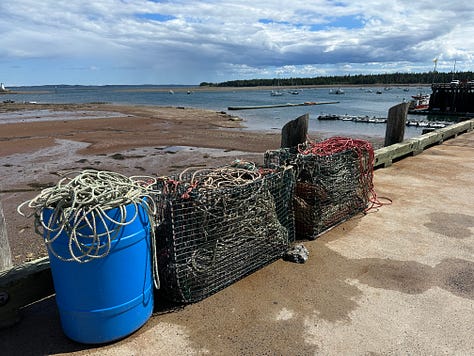
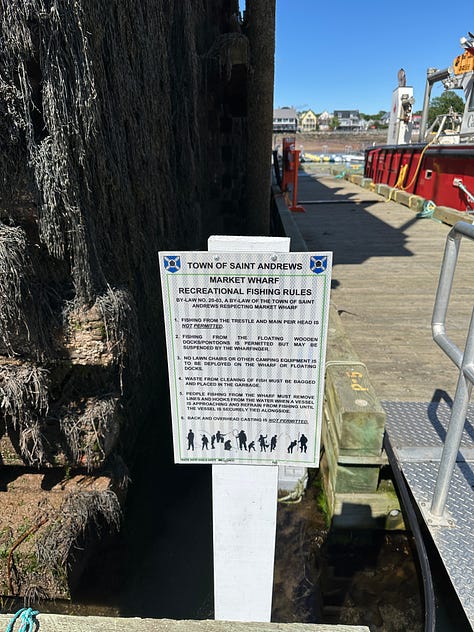
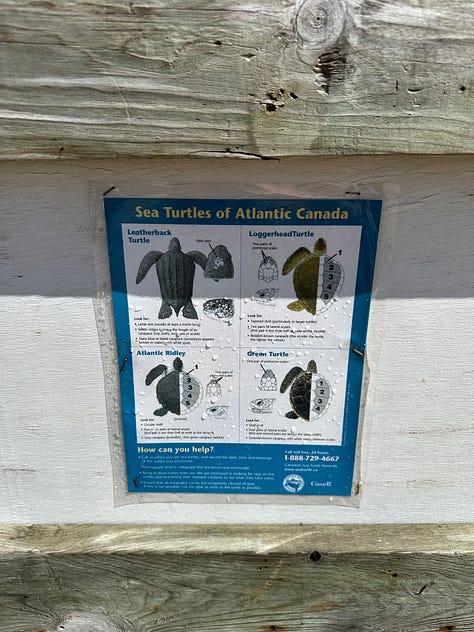
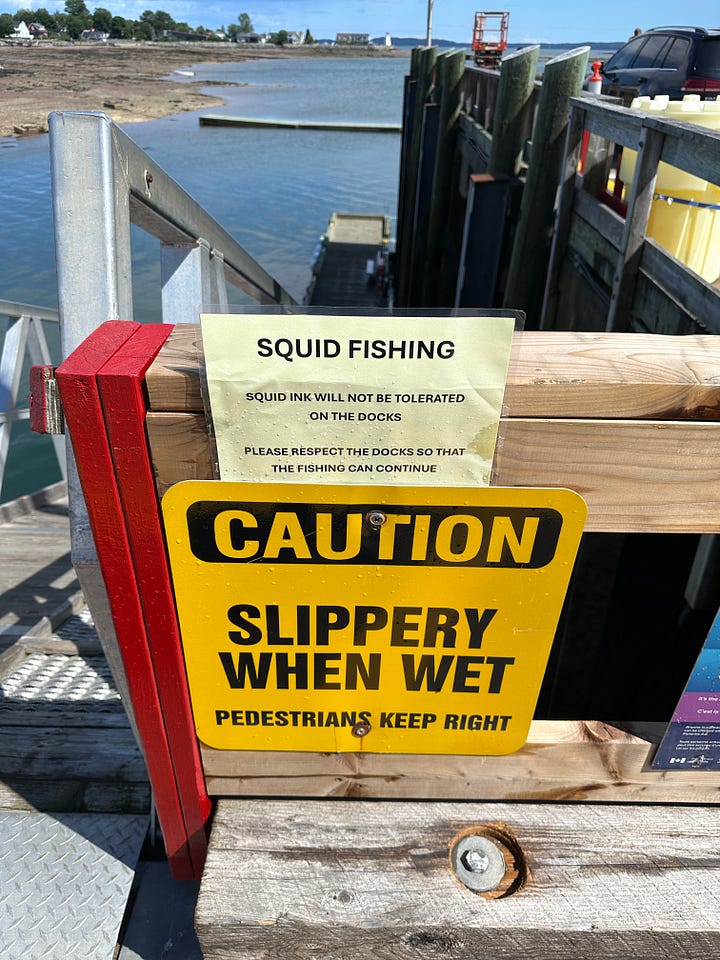
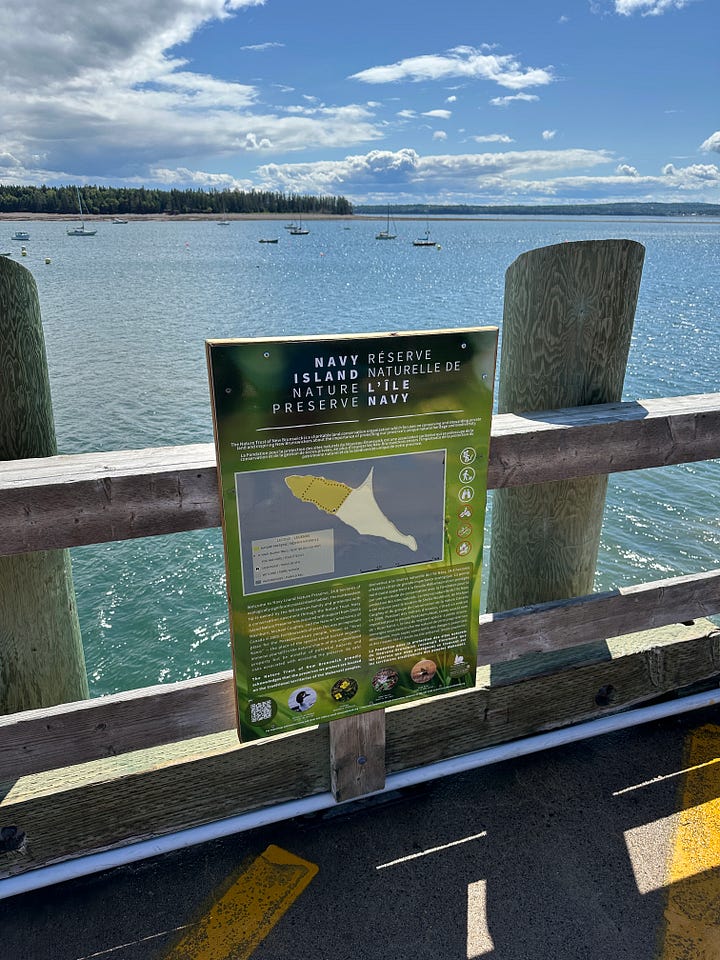
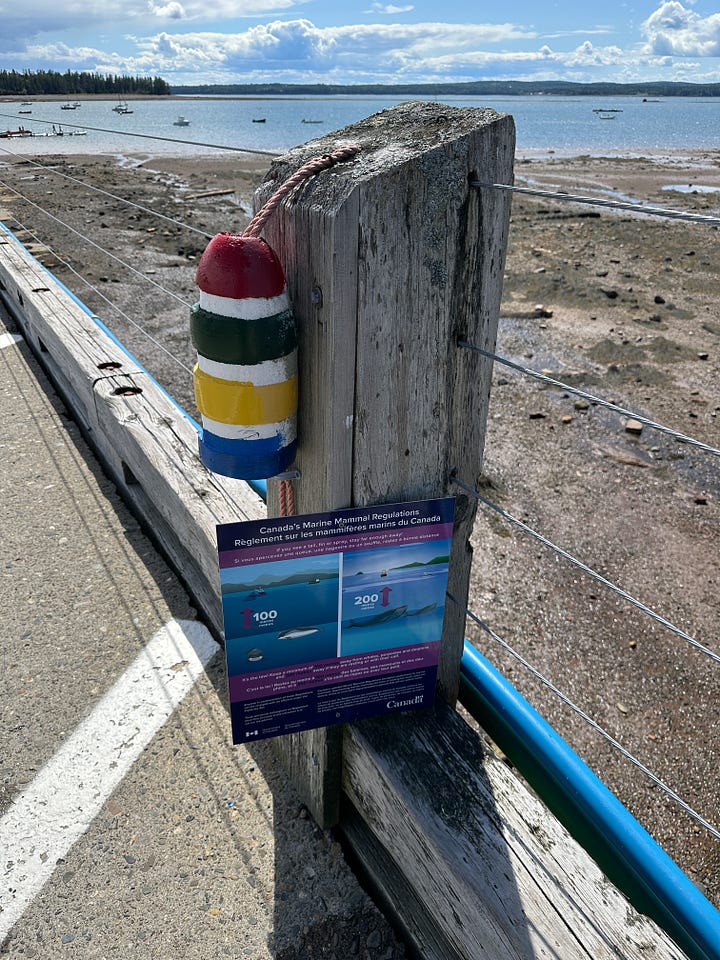
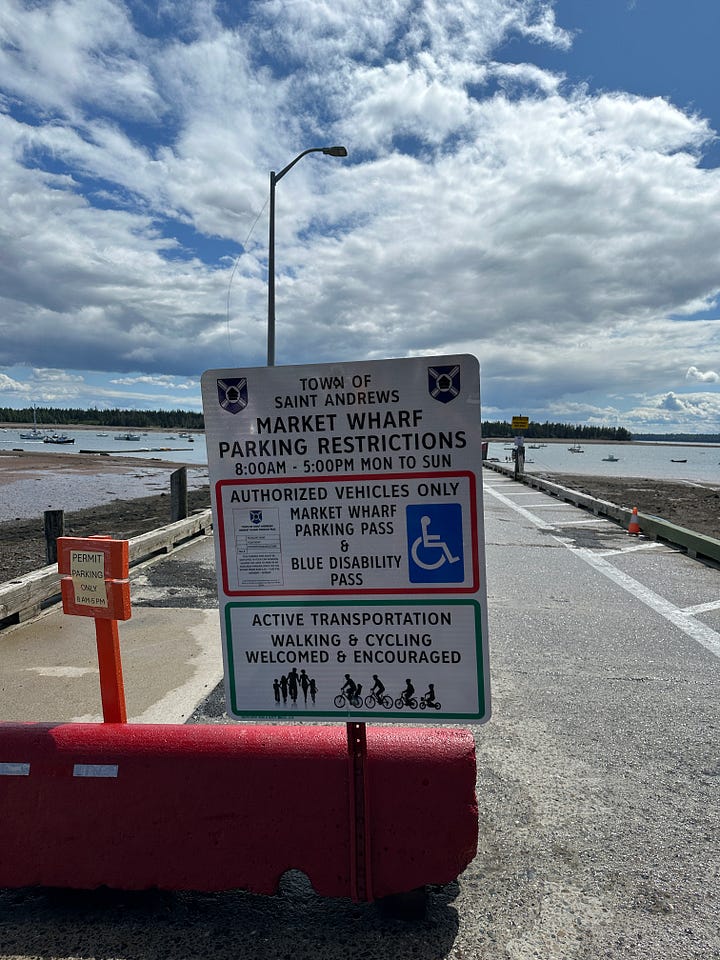
If I was going to park my bike (my one gripe with the town is there aren’t obvious and clear places to do this - correct me if I’m wrong municipal employees and I will retract!) and walk a short route, I’d probably do it like this, starting at the Alongquin Hotel and walking down through the pleasantly quiet residential lanes, to Water Street, and back again. There’s also a hop-on-hop-off bus option for those that need it, in the summer months.
Click this link to pull up the walking map on your iPhone, if you’d like a copy on hand for your travels. There’s nothing like St. Andrews in the summer.
—
All we need is a point of view, a set of tools, and a lot of time.
See you on the road.
“By walking through a city, you meet the people who live there, and engage with them and their culture, on their terms in their environment. It allows you a small window into how they live. How they think about and experience the world. Consequently, it can change how you see the world.” - Chris Arnade








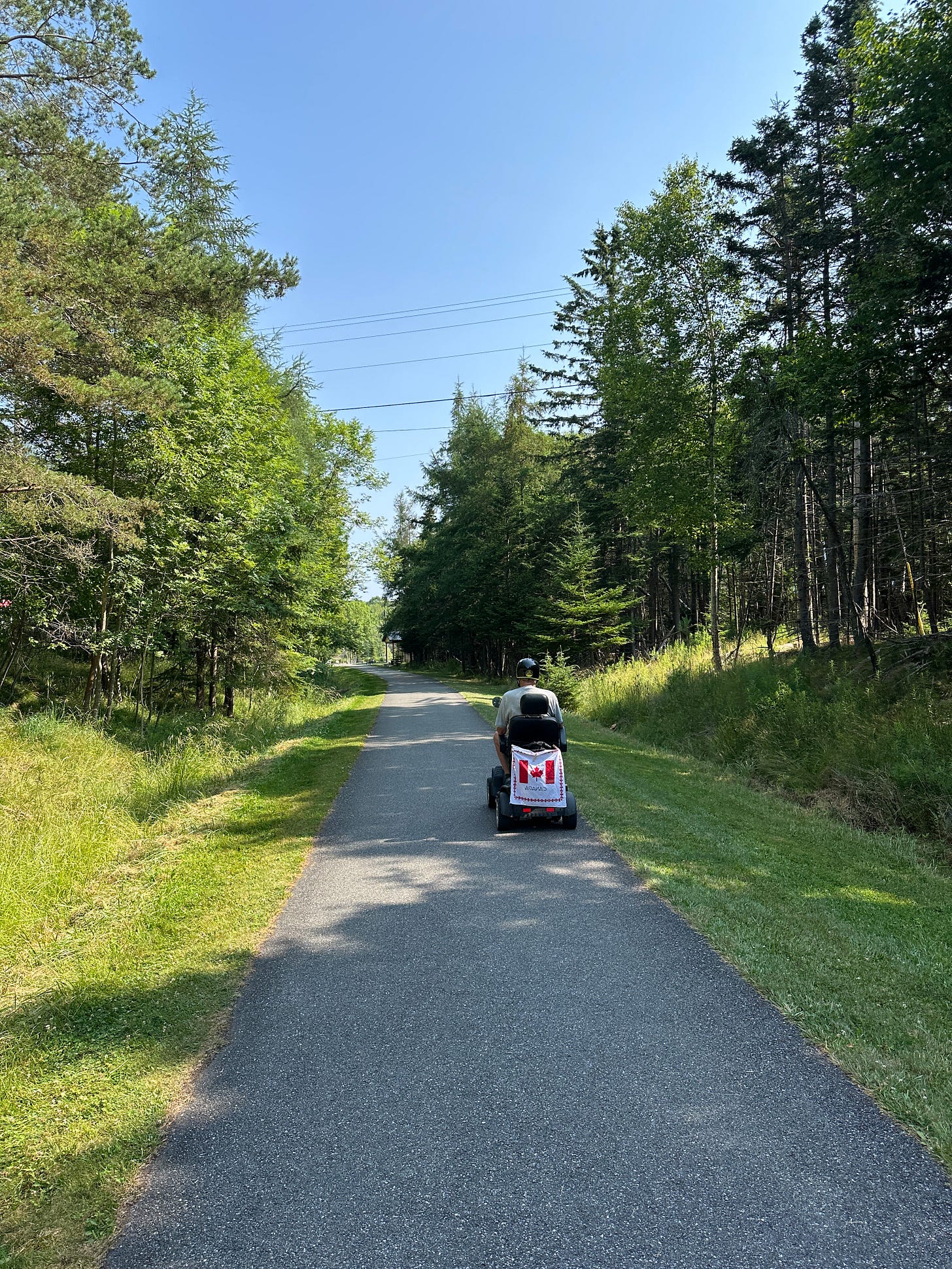



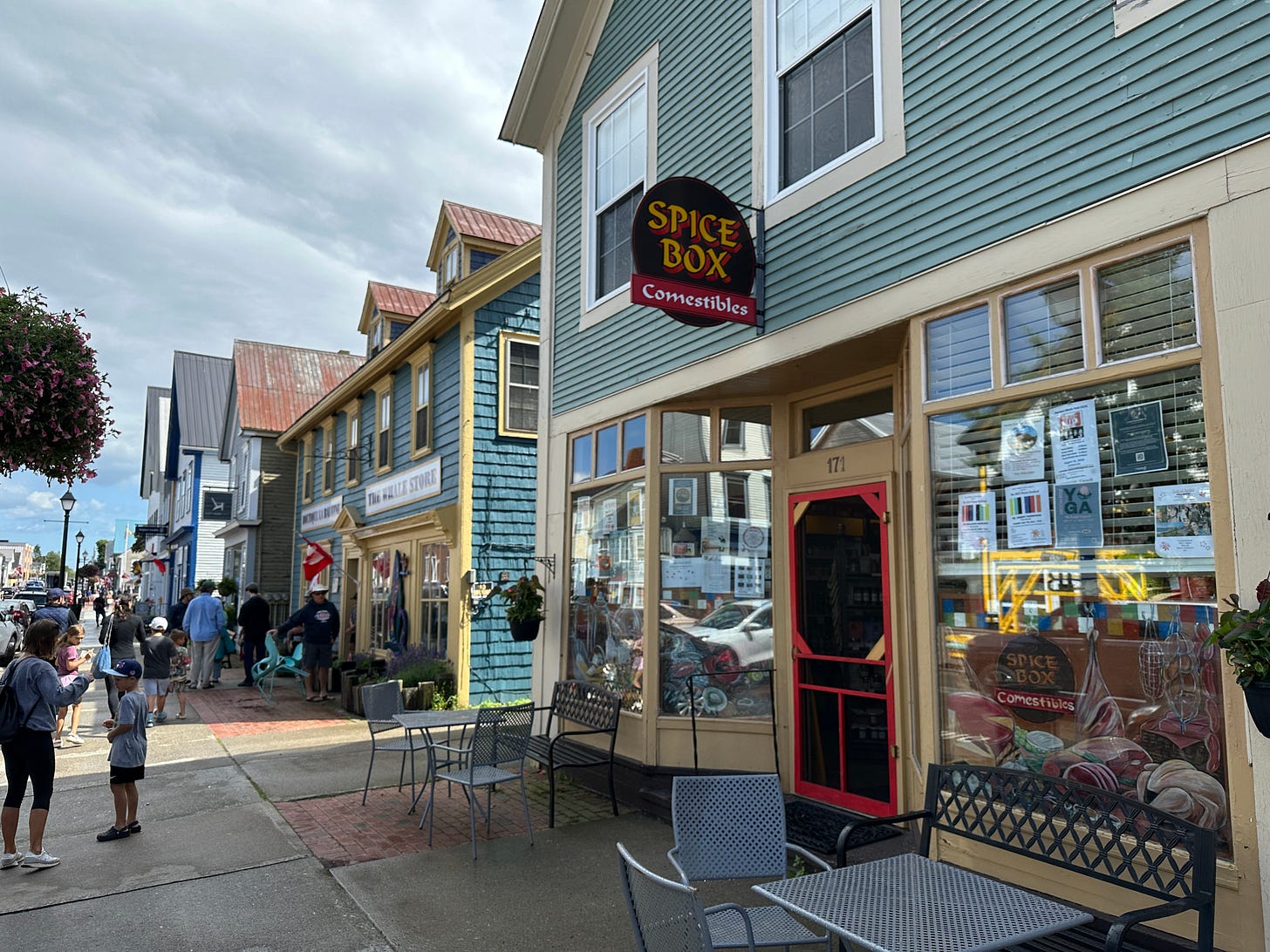
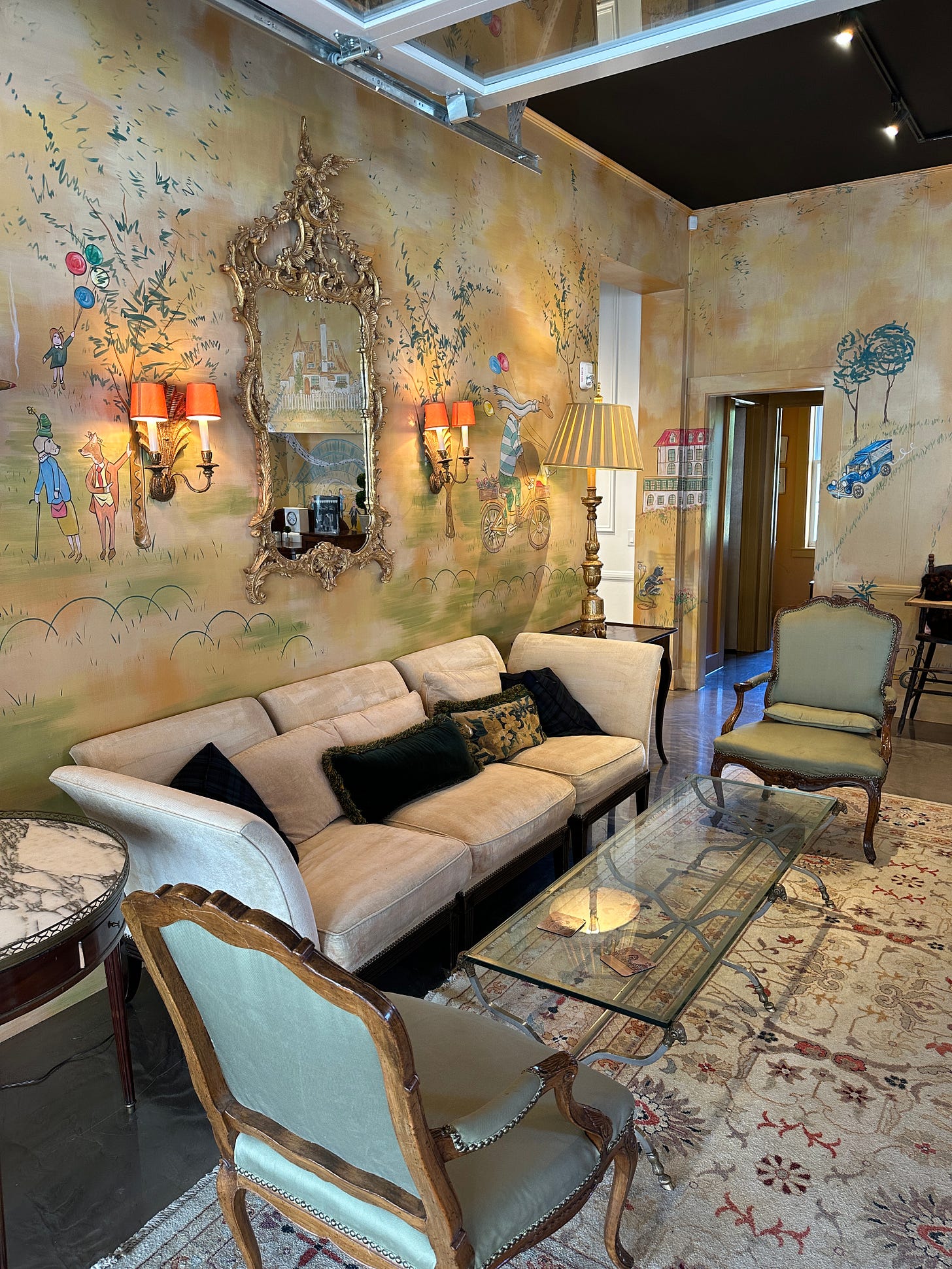
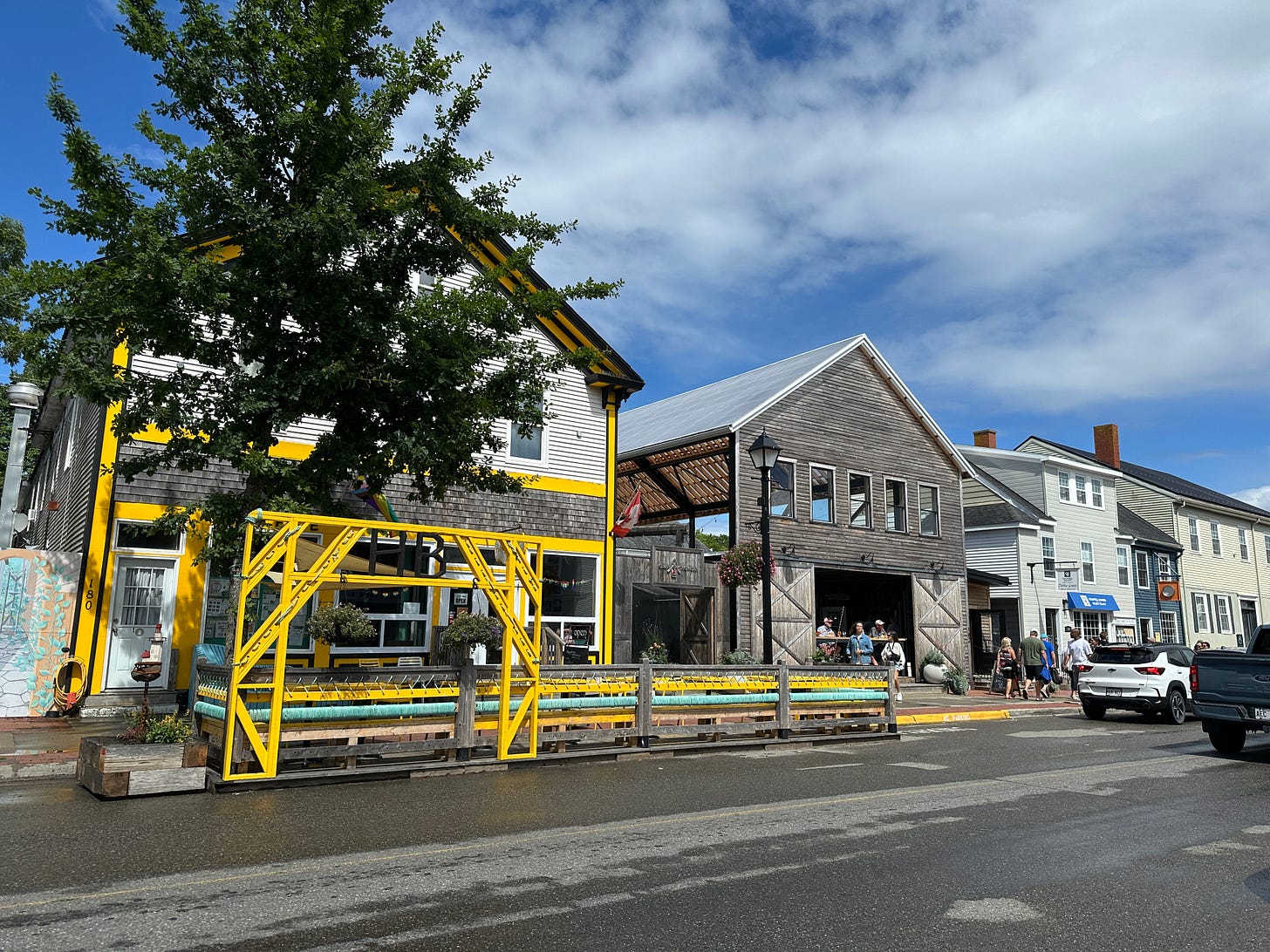

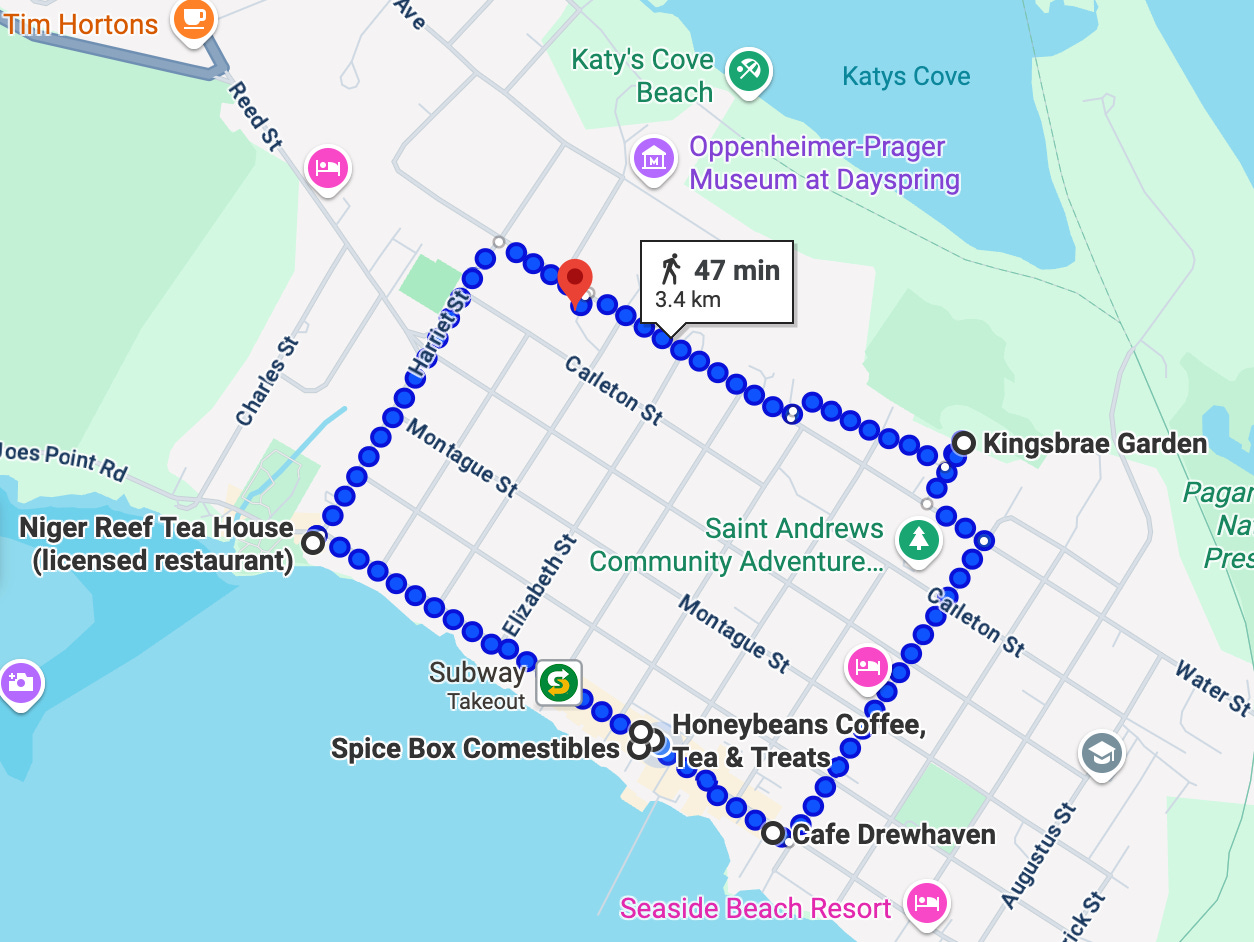

I’ve always wanted to run the wharf to wharf race in St Andrews, but never was able to pull it off. Next one hopefully